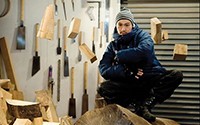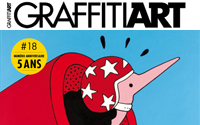.png)


The Art of the Real in Painting
A fringe group of “realist” contemporary artists deals with the representations of reality, a tradition in art history that has been with us since the mimesis of Antiquity. These artistic practices appear to us to be fully representative of the art of today, at a time when the taste for painting and technicality is prevalent. Whether taking a hyperrealist or deconstructed formal approach, these artists reflect on our postmodern society, the history of paintings and the representation of humankind and the city.
When exploring the relationship between art and reality, we must look to the concept of mimesis to understand the various formal issues surrounding figurative art. Plato uses this term in The Republic to refer to the arts of imitation, thus telling the story of Zeuxis’ work Child Carrying Grapes, where the bunch of grapes was painted so realistically that birds came to peck at it, or so the legend has it. Ever since then, the representation of reality has formed the basis for all artistic explorations, without even concerning ourselves with the iconographic field. Some artist, in search of grapes, see technicality as a way of achieving artistic fulfillment, hence it became a key characteristic of the hyperrealist painters (and sculptors) in the 60s and 70s, as well as many other artists after them, on a quest for the most perfect objectivity. Dan Witz for example aims to achieve a photorealistic effect and builds a cultural bridge between the work of Edward Hopper and the Flemish painters of the Renaissance, also joining up with the hyperrealist movement in the field of digital painting, where the human form is given a central place.
The artist effectively seeks to find out who they are through the depiction of their double – the ego – in the conventional context of the portrait in particular, an important part of the hyperrealists’ iconography. A fringe group of artist from an urban art background or working on the urban contemporary art scene nonetheless sets itself apart from these contingencies and displays an academic characterized by a degree of subjectivity in its relationship to reality. This academism results in very long production times – sometimes several dozens or hundreds of hours of work – explained by the use of oil paint and its long drying times. Like the hyperrealist painters, they are dealing with a personal challenge; although the goal is no longer that of photorealism, technique is paramount. Subjectivity can take many forms here, but we have chosen to discuss two main ones: a surrealist vision of the world providing a realistic depiction of the chaos of society (Jeremy Geddes, Kevin Peterson), and a formal treatment that tends towards abstraction while showing reality in an almost documentary style (Sebas Velasco). Lucian Freud explains it perfectly: “The longer you look at an object, the more abstract it becomes, and, ironically, the more real.” This treatment of reality is this generation’s greatest pictorial asset, as these artists play with light, textures and colors to elevate the scenes, objects and emotions that we know and consider banal, in short.
Among these artists, there is no excessive conventionalism or excessive naturalism, but a precise study of perception through their anchoring in reality, as a way of mastering the world and the place we occupy in it. In the urban society in which we live, the city is central to our personal histories. It has always been a source of inspiration for artists: architecture and town planning, the very creations of humankind; the city as a living organism in its own right which devours its creator; the city as a frame for our daily life, the staging of itself. The treatment of this fascinating iconographic field also ranges from realist to surrealist: the city and graffiti (Jessica Hess, Kevin Cyr, Sebas Velasco), the city and its inhabitants (Joel Daniel Philips), and the city and its architecture, to the point of exploring many social themes such as habitat, poverty, industrialization and ecology. A style of landscape painting, therefore, with its own special status, between order and chaos, on a perpetual quest for meaning.
Image 1 and 2 caption: Dan Witz defines himself as a realist academic artist. By taking his own photos, editing them in Photoshop and then working on them with oil paint, they have a relationship to reality that is immediate, whether studying light (Cell Phones) or movement (Mosh Pits).
Image 3 caption: Brett Amory’s approach to reality is about pending and observing; when light and movement become unified, the movement is caught. A shop window, a subway train, a bar front and people, all anonymous, who are depicted with oil paint that allows unequalled shadow and light effects.






